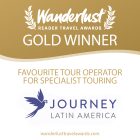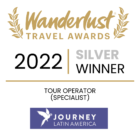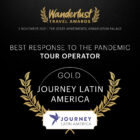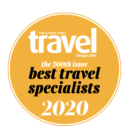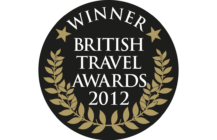Private Journeys
Self-drive Ecuador: The Avenue of the Volcanoes
11 days from £2,850pp
(based on two people sharing & excluding flights)
Essentials
-
Tour info
-
Country info
-
What's included
Tour info
Transport
8 days self-drive hire car. Suzuki SZ 2.4L 4×2 Automatic transmission or similar.
Accommodation
This holiday incorporates smart mid-range hotels with character in Quito and Cuenca, a modern business style hotel in Guayaquil and small, friendly countryside lodges on the Avenue of the Volcanoes and close to Cotopaxi National Park. The countryside hotel in Baños has spa facilities.
Meals
Breakfast daily, dinner days 3 and 4.
Guides
We carefully select our local partners, some of whom we have worked with for over 30 years. Their English-speaking guides understand the expectations of our clients very well, and are consistently singled out for praise by the latter on their return.
Summary Of Nights
11 days, 10 nights: Quito 2, Cotopaxi 1, Quilotoa 1, Baños 2, Alausi 1, Cuenca 2, Guayaquil 1.
Currency
The unit of currency in Ecuador is the US dollar.
How To Take It
Cash machines are available in all major cities and towns, and so taking a debit or credit card with a PIN number is the most convenient way of withdrawing money while on your trip, and in most shops and restaurants you can also pay by card. However, since cards can get lost, damaged, withheld or blocked, you should not rely exclusively on a card to access funds.
We recommend that additionally you take a reasonable quantity of US dollars cash (no more than is covered by your insurance). Dollar bills should be in good condition, soiled or torn bills may be refused.
Daily Spend
It is very difficult to give a guideline for essential expenses but a budget of around US$50 per person per day should cover the cost of good quality meals,drinks and the odd souvenir. Other expenses include petrol (probably no more than about $US100) and tips (see separate paragraph), optional excursions and entry fees.
Tipping
Tips are welcomed and local guides often rely on their tip as a significant proportion of their income.
Most service industry workers will hope for a tip of some kind and so it is useful to have spare change for hotel porters, taxi drivers and the like. It is common to leave 10 – 12% in restaurants.
Tipping guidelines can be found in our Briefing Dossier.
Insurance
Travel insurance is essential. Details of our recommended policy can be found on our Travel Insurance pages. Total Damage Waiver (LDW – zero excess) Insurance for your hire car is included in the price of the holiday, please inquire if you would like to upgrade it. .
Airport Taxes
If you have purchased your flights through Journey Latin America, the international departure tax is usually included in the ticket.
Trip Suitability
This holiday is suitable for all able, reasonably fit visitors.
The driver should have reasonable experience and be a confident driver. While most of the roads are paved, they can involve blind bends and steep gradients. The behaviour of local drivers with regard to the rules of the road is not always predictable. 4WD off-road experience is not necessary but some experience of diving on gravel roads and tracks is advisable. Minimum age of driver 21, upper limit 80. A second driver can be added for an extra charge. See our separate document for more information about the car hire element of the holiday. .
Visas
Holders of a full British passport do not require a visa, although passports must be valid for at least 6 months after the trip begins. Anyone with a different nationality should enquire with us or check with the relevant consulate.
If flying to the US, or via the US you will need to fill in your online ESTA application.
Climate
Lying at 2-4,000m close to the equator, the highlands, including the cities of Quito and Cuenca, have a permanent spring-like climate: altitude is the determining factor with regard to temperature. The rainy season in the Andes runs between January and April when there are showers most afternoons. The dry season is June, July and August when the sun is strong during the day, but at night the temperature drops dramatically (maybe as low as freezing point). May, September and October are less predictable, with both rainy and sunny spells. In the mountains at any time of year you should expect a variation between 15°C and 25°C. Baños has a pleasant sub-tropical climate with an average year-round daytime temperature of 25°C, where January is the hottest month, July the coolest and February the driest. Guayaquil on the Pacific coast has a tropical climate, hot and humid all year round with an average daytime maximum temperature of around 30°C.
Altitude
Several days are spent at high altitude (over 2.500m). You may notice the effect of high altitude; symptoms vary: most common are mild headaches and breathlessness. If you drink plenty of water and allow your body to acclimatise (don’t exert yourself or drink alcohol) in the first couple of days after arrival, you will minimise your chances of being adversely affected.
Following a couple of days in Quito you visit the high altitude Cotopaxi National Park and may elect to drive up to the volcano’s snow line at 4,800m. Only do so if you are not feeling any symptoms of altitude sickness, such as dizziness and nausea.
Please refer to our Briefing Dossier for further information.
Clothing And Special Equipment
For day-to-day wear you should go prepared to encounter all seasons. Both warm clothing and a sun hat are essential at altitude; a light fleece jacket and a waterproof/breathable outer shell makes a good combination.
Strong, comfortable footwear is essential and you should bring insect repellant, sun block, hat and sun glasses.
Don’t forget your camera, charger and cards.
Please get in touch with the office before departure if you have any doubts.
Vaccinations
Preventative vaccinations are recommended against the following: typhoid; polio; tetanus; hepatitis A. You should consult your GP for specific requirements.
You can also find helpful information on the Masta Travel Health website.
Country info
When is the best time to visit Ecuador and Galapagos?
The country is an all-year-round destination. The highlands, at about 2,800m but astride the Equator, have a permanent spring-like climate. Most days have a sunny morning but there may be rain in the afternoon. The coast is very hot (30°C) and humid from Jan-Apr. It’s a bit cooler and drier from May-Dec. The jungle is hot and humid all year.
For more detailed information visit our When To Go section.
What is the official language of Ecuador and Galapagos?
The official language in Ecuador and the Galapagos Islands is Spanish.
What is the official currency in Ecuador and Galapagos?
The official currency of Ecuador is the US dollar. Notes can be withdrawn from the many ATMs in larger towns and cities using a UK credit or debit card.
What is the time difference between Ecuador and Galapagos and UK?
The time difference between the UK and Ecuador and the Galapagos Islands is GMT-5 hours.
Do I need a visa for Ecuador and the Galapagos?
Holders of a full British passport do not require a visa, although passports must be valid for at least 6 months after the trip begins. Anyone with a different nationality should enquire with us or check with the relevant consulate.
If flying to the US, or via the US you will need to fill in your online ESTA application.
What vaccinations do I need for Ecuador and Galapagos?
Please check Travel Health Pro for information on health recommendations and vaccinations for the destinations you are visiting. Please note that many Latin American countries require proof of vaccination against Yellow Fever if you have recently travelled to another country where Yellow Fever is present.
What places combine well with Ecuador and Galapagos?
The Galápagos Islands, (1.5 - 3 hours by air from Guayaquil of Quito); a tour in Colombia to the north, with daily flights from Bogotá to Quito taking just 1.5 hours; the Inca archaeological sites of Peru (daily flights Lima to Quito take 2 hours 20mins).
What are the festivals and cultural events in Ecuador?
There are carnivals throughout the country, usually around February-March. Be warned that the boisterous festivities include water fights from which no visitor is safe.
Semana Santa (Easter) takes place throughout the country usually between March-April. There will be religious processions throughout this period.
Todos los Santos (all souls day, day of the dead) is also celebrated throughout the country on the 2nd November. Flower laying ceremonies in will take place in cemeteries. These are particularly striking in rural areas.
How do I adapt to the altitude in Ecuador?
Ecuador’s high Andean spine is bookended by the Pacific coast and Amazon Rainforest, with Quito at 2,850m. Travel to high altitude can cause mountain sickness and even if you feel fighting fit it’s important to take things easy and stay hydrated (drink plenty of water, avoiding alcohol and caffeine) as you get used to the thin, dry air. You may initially notice a headache, dizziness or breathlessness and this usually improves with acclimatisation. If you are pregnant or taking the contraceptive pill, have a medical condition such as heart or lung condition, anaemia, asthma, high blood pressure you should seek the advice of your GP before booking. We also recommend you check your travel insurance covers travel to high altitude. If you’re taking the family, remember small children may be less capable of communicating altitude-related symptoms effectively: keep an eye on them too. Rest assured we will plan your itinerary carefully, taking into account any time spent at altitude. If you have any questions or concerns about altitude please speak to your travel expert.
Further advice on travel to altitude is available on www.travelhealthpro.org.uk
Inspired by this trip
Our exciting range of articles on Latin America explore everything from iconic destinations and lesser-known cultural gems to delicious traditional recipes. You’ll also find exclusive travel tips, first-hand client reviews and the chance to get your personal questions answered by our travel experts.
Papagaio
Your edit for Latin American inspiration
Our exciting range of articles on Latin America explore everything from iconic destinations and lesser-known cultural gems to delicious traditional recipes. You’ll also find exclusive travel tips, first-hand client reviews and the chance to get your personal questions answered by our travel experts.
View Extraordinary Inspiration










